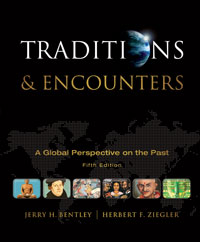1 A) written records uncovered in Harappa and other Dravidian cities. B) archeological discoveries of Harappan physical remains below the water table. C) archeological discoveries of Harappan physical remains above the water table. D) the Vedas and the Upanishads. E) All these answers are correct. 2 A) wheat, barley, chicken, cattle, sheep, and goats. B) soybeans, sorghum, rice, pigs, and fish. C) sweet potatoes, tomatoes, maize, and cacao beans. D) millet, yams, and legumes, but no meat. E) None of these answers is correct. 3 A) the Harappan state was very oppressive, forcing different racial groups to adopt the same standards. B) there might have been a central authority powerful enough to reach all corners of society. C) there was a high degree of commercialization in the economy. D) these cultures actually migrated from Mesopotamia. E) None of these answers is correct. 4 A) gold, gems, and decorative items. B) bathrooms, showers, and toilets. C) foods, clothes, and hairstyles. D) houses, ovens, and wells. E) All these answers are correct. 5 A) it was very common for the peoples in other early agricultural societies to honor fertility gods or goddesses. B) the bronze figurine of a dancing girl discovered at Mohenjo-daro reveals this point. C) of the similarities between the images of Harappan deities and the images of Hindu fertility deities. D) there is written documentation to support it. E) None of these answers is correct. 6 A) frequent epidemics made city living impossible. B) deforestation of the Indus River valley brought about ecological degradation. C) the horse-riding Aryans began to invade the cities. D) the Indus River dried up. E) All these answers are correct. 7 A) forcibly drove the Harappans out of their cities. B) came suddenly, in a massive migration. C) entered the Indus valley at the height of the Harappan society. D) refused to intermingle with the Dravidians. E) None of these answers is correct. 8 A) were primarily herders. B) utilized horses for transportation. C) judged wealth by the number of cattle. D) called themselves Aryans. E) All these answers are correct. 9 A) this was how the Aryans referred to this period. B) the four earliest religious texts were compiled in this period. C) this was the period in which the Indians were particularly religious. D) the major god was Vedas. E) None of these answers is correct. 10 A) jati .B) brahmins .C) varnas .D) shudras .E) None of these answers is correct. 11 A) was a central institution that served to promote social stability. B) was incapable of accommodating social changes. C) was actually not much of a restriction on the upward mobility of individuals. D) did not persist beyond the Vedic age. E) None of these answers is correct. 12 Rig Veda offered a brief account of the origins of the four varnas (castes). It was said thatA) the four castes were created according to the wills of Indra and Agni (the god of fire). B) Purusha, a primeval being, sacrificed himself in order to create the four castes. C) the brahmin priests created the four castes with themselves at the top. D) the gods created the castes during the early days of the world so that brahmins and kshatriyas would lead their societies. E) None of these answers is correct. 13 A) patrilineal descent B) the Lawbook of Manu C) the practice of sati D) the fact that women had no responsibilities for religious rituals E) All these answers are correct. 14 A) ritual sacrifices and the god of war. B) fertility and immortality. C) spirituality and meditation. D) building religious buildings. E) All these answers are correct. 15 A) the spiritual longing of the Aryans. B) the further development of the religious tradition of the Dravidians. C) a how-to book of religious ritual. D) the blending of Aryan and Dravidian values. E) None of these answers is correct. 16 A) to attain the state of samsara . B) to attain the state of moksha . C) to avoid one’s karma . D) to separate from Brahman . E) to practice yoga . 17 A) each person is part of a larger cosmic order. B) the highest goal of the individual is to escape the cycle of birth and rebirth. C) individuals who live virtuous lives and do their duty can expect rebirth into a purer form. D) ascetics and meditation are vehicles for escaping the cycle of birth and rebirth. E) All these answers are correct. 18 Rig Veda ,A) the world was created by Indra and his thunderbolts. B) equality is the main goal of society. C) the world was created when the gods sacrificed Purusha. D) the ultimate existence is sati . E) None of these answers is correct. 19 A) be attached to the material world as closely as possible. B) ignore ethical standards, since these standards were not the ultimate reality. C) observe high ethical standards like honesty, self-control, and charity. D) avoid any inclinations to gain self-knowledge. E) None of these answer is correct. 20 A) often are vegetarians. B) believe you should respect all living things, even animals and insects. C) believe that animals might be holding incarnations of unfortunate souls. D) believe humans should have compassion for the suffering of the souls in animals. E) All these answers are correct.





